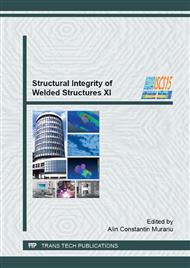[1]
T. Nicholas, High Cycle Fatigue – A Mechanics of Materials Perspective, Elsevier, (2006).
Google Scholar
[2]
I. Dumitru, The basics of fatigue calculation, Eurostampa Publishing House, 2009 (in Romanian).
Google Scholar
[3]
Quoc Huy Vu, Fatigue polycyclique multiaxiale de l'acier C35: caracterisation et modelisation des mecanisms d'endommagement, PhD Thesis, University of Poitiers, (2006).
Google Scholar
[4]
C.C. Chu, F.A. Conle, F.F.A. Bonnen, Multiaxial stress-strain modeling and fatigue life prediction of SAE axle shafts, Advances in Multiaxial Fatigue, ASTM STP 1191, 1993, pp.37-54.
DOI: 10.1520/stp24794s
Google Scholar
[5]
I.V. Papadopoulos, Critical plane approaches in high-cycle fatigue: On the definition of the amplitude and mean value of the shear stress acting on the critical plane, Fat & Fract Eng Mat & Struct 21 (1998) 269-285.
DOI: 10.1046/j.1460-2695.1998.00459.x
Google Scholar
[6]
Y. Verreman, H. Guo, High-cycle fatigue mechanisms in 1045 steel under non-proportional axial-torsional loading, Fat & Fract. Eng. Mat. & Struct. 30 (2007) 932-946.
DOI: 10.1111/j.1460-2695.2007.01164.x
Google Scholar
[7]
L. Reis, B. Li, M. de Freitas, Analytical and experimental studies on fatigue crack path under complex multi-axial loading, Fat & Fract. Eng. Mat. & Struct, 29 (2006) 281–289.
DOI: 10.1111/j.1460-2695.2006.01001.x
Google Scholar
[8]
A. Karolczuk, E. Macha, A review of critical plane orientations in multiaxial fatigue failure criteria of metallic materials, Int. J. Fract., 134 (2005) 267-304.
DOI: 10.1007/s10704-005-1088-2
Google Scholar
[9]
A. Chamat, M. Abbadi, J. Gilgert, F. Cocheteux, Z. Azari, A new non-local criterion in high-cycle multiaxial fatigue for non-proportional loadings, Int. J. Fat. 29 (2007) 1465-1474.
DOI: 10.1016/j.ijfatigue.2006.10.033
Google Scholar
[10]
J. Papuga, M. Ruzicka, Analysis of present criteria for damage description caused by multiaxial loading, Report No. 2051/01/4, 2002, Technical University of Prague.
Google Scholar
[11]
I. Dumitru, L. Kun, M. Sava, M. Hluscu, Considerations on the necessity of determining principal stresses and directions for analysis of material durability under multiaxial fatigue, Key Eng Mater, vol. 601 (2014) 17-20.
DOI: 10.4028/www.scientific.net/kem.601.17
Google Scholar
[12]
D. Skibicki, Experimental verification of fatigue loading nonproportionality model, J. Theoret. Appl. Mech., 45(2) (2007) 337-448.
Google Scholar
[13]
L. Kun, Modeling and Simulation of Multiaxial Fatigue, PhD Thesis, Politehnica University of Timisoara, Romania, 2012 (in Romanian).
Google Scholar
[14]
S. Lee, A criterion for fully reversed out-of-phase torsion and bending, in: K. Miller, M. Brown (Eds. ), Multiaxial Fatigue, ASTM International., Philadelphia, 1985, pp.553-568.
DOI: 10.1520/stp36242s
Google Scholar
[15]
L. Susmel, N. Petrone, Multiaxial fatigue estimations for 6082-T6 cyclindrical specimens under in-phase and out-of-phase biaxial loadings, in: A. Carpinteri et. al. (Eds. ), Biaxial and Multiaxial Fatigue and Fracture, ESIS, 2002, pp.83-104.
DOI: 10.1016/s1566-1369(03)80006-7
Google Scholar
[16]
C. Braccesi, F. Cianetti, G. Lori, D. Pioli, An equivalent uniaxial stress process for fatigue life prediction of mechanical components under multiaxial stress conditions, Int. J. Fat 30 (2008) 1479-1497.
DOI: 10.1016/j.ijfatigue.2007.09.011
Google Scholar


